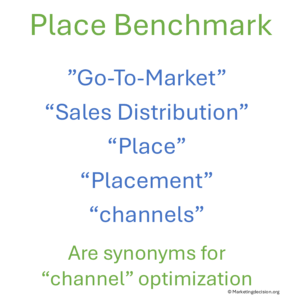 Channel Benchmarking is a cornerstone activity when evaluating the current sales organization and defining future Go-to-Market strategies.
Channel Benchmarking is a cornerstone activity when evaluating the current sales organization and defining future Go-to-Market strategies.
It provides a clear and structured view of the AS-IS situation before any transformation is launched. Once changes are implemented, the benchmark enables comparison between targeted and achieved results, highlighting the success of transformation initiatives and generating valuable learning points for future improvements.
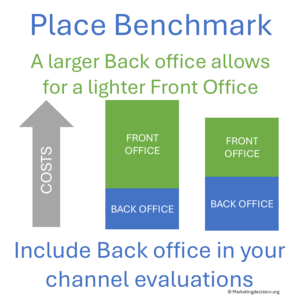
In the context of the Marketing Mix, various expressions can be used to target the same objective of the marketing mix channel benchmark such as “Go-to-market assessment”, “sales distribution benchmarking”, “Place or placement Benchmarking” — aiming to assess how effectively a company delivers its products or solutions to the market.
When assessing the sales organization, direct or indirect, remember to include all front office teams – sales, support, help desks and also the back office, which supports the front line. A large sales team without balanced support functions can be less efficient and more costly than a smaller, well-structured organization. Evaluating a sales organization goes way beyond the expected first line of sales specialists or account managers. It includes many other functions that with proper mix of competencies will support the company objectives.
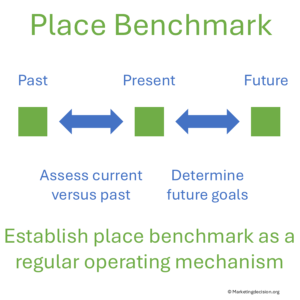 Benchmarking serves two main objectives:
Benchmarking serves two main objectives:
The process acts as a one-time snapshot of the organization’s readiness before major transformation.
Engaging multiple people from sales and other functions to assess the Go-to-Market model may create tensions, yet these discussions are essential. Benchmarking should be viewed as a collaborative journey with long-term impact on business planning and marketing decisions.
Consider using supporting tools from our Decision chapter such as the Stakeholder Analysis or the Scope frame in/out to prepare and guide team discussions. The Benchmark tool proposed in this chapter will address the core questions to assess current organization capabilities.
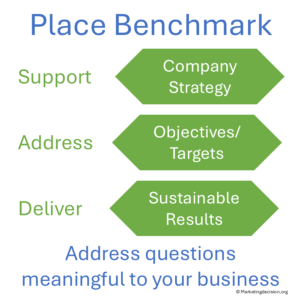 Powerful questions can help determine and keep alignment between your sales organization and business priorities:
Powerful questions can help determine and keep alignment between your sales organization and business priorities:
These and other questions, specific to your market environment, will help guide your optimization efforts. This is an example of the importance of the “why” question which is the core topic of the Decision-Making chapter of this site. Please refer to the tools in this decision chapter to structure and facilitate discussions and reach targeted objectives.
Answering these questions helps define the efficiency and balance of your channel structure, preparing the ground for future Go-to-Market improvements.
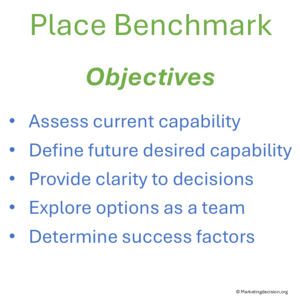
The Channel Benchmark Framework provides 5 key steps to structure discussions and identify the most efficient sales and support organization for each market and segment.
This structured approach ensures that decisions are made with a clear understanding of benefits, risks, and trade-offs, and that every team shares the same rationale before implementing any transformation.
1. Understand the current capability and why it is assessed as such.
Analyze existing performance and organizational capacity to establish a factual baseline for discussion.
2. Define the future capability with clear justification.
Describe the desired future state and link each proposed change to company priorities, market opportunities, or efficiency gains.
3. Clarify decision rationales when discussions lack depth.
Ensure that each choice—whether structural or strategic—is supported by reasoning, not assumptions. Document these rationales for future review.
4. Evaluate alternative scenarios and test options.
Compare possible models or structures using both qualitative and quantitative criteria. Encourage open debate within the team to uncover innovative approaches.
5. Determine critical success factors such as flexibility, speed, and resilience.
Identify the organizational attributes that will make the transformation sustainable and adaptive to market change.
Together, these 5 steps strengthen the quality of the benchmarking process and create a foundation for measuring transformation success over time.
They also provide a repeatable framework that teams can use in future channel reviews or when expanding into new markets.
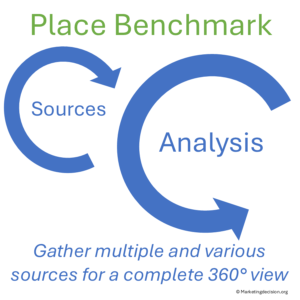 Channel Benchmarks enable comparison across regions or segments, revealing insights into capacity, flexibility, and engagement.
Channel Benchmarks enable comparison across regions or segments, revealing insights into capacity, flexibility, and engagement.
Whenever possible, comparing your structure with that of competitors provides powerful learning.
For example, reviewing sales recruitment announcements can reveal competitor focus areas, team structures, and evolving sales capabilities.
Like a Stakeholder Analysis, Channel Benchmarking involves input from multiple functions. Individual assessments can later be discussed collectively to identify strengths, weaknesses, and improvement priorities.
Addressing gaps and needs within an organization through proper analysis is a key factor for successful transformation.
BCG highlights the importance of evolving traditional sales approaches, transforming the classical “Milkman” Go-to-Market model to reconsider the real value delivered to customers.

A useful method recommended by BCG involves interviewing employees to identify what is important and where improvements are most desired. By creating this internal mirror, companies can compare themselves and design new organizational approaches.
Read the full article:
BCG: Moving Beyond the Milkman Model (2017)
BCG: Six Design Strategies for the Next-Generation Commercial Model (2021)
Assessing a sales organization and considering alternative approaches requires recognizing that there are multiple sales organization structures with different sales roles.
One common discussion focuses on specialists versus account managers.
When a company offers only a few products, account managers can handle most technical discussions. However, when multiple offerings exist, product specialists become essential — bringing expertise that no single account manager can maintain across many solutions.
Balancing the number of specialists and account managers is a fine adjustment requiring ongoing evaluation.
For further exploration:
These articles discuss the emergence of hybrid sales roles, which blur the distinction between inside and outside sales. They explore how multiple sales functions interact and how Channel Benchmarking can support the analysis of these evolving models.
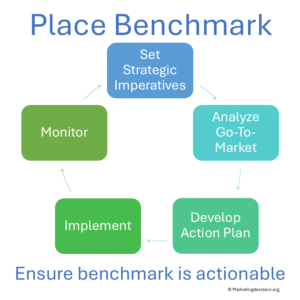
Channel Benchmarking acts as a revealer for needed adjustments or deeper transformations in a company’s Go-to-Market approach.
Through structured analysis, it brings attention to the “why” of transformation, ensuring that discussions occur before execution planning begins.
It also enables teams to compare with competitors, highlight opportunities, and set priorities for future sales optimization.
Use decision tools presented in the new Marketing Mix Decision section to identify which initiatives matter most, why they matter, and how to implement them efficiently.
A Channel Benchmark is a structured evaluation method used to assess the effectiveness of a company’s sales and distribution organization. It compares the current AS-IS performance with the desired TO-BE model, revealing improvement opportunities in Go-to-Market strategy, sales coverage, and support functions.
In the Marketing Mix, Place represents how a company delivers products or solutions to customers. The Channel Benchmark builds on this idea by providing a measurable framework to evaluate the efficiency of sales and distribution channels — making the Place Benchmark a practical tool for Go-to-Market optimization.
Why is conducting a Channel Benchmark important before transforming a sales organization?
A Channel Benchmark offers a clear baseline for evaluating the current organization before transformation. It ensures that structural changes are based on facts and that resources are properly balanced across direct and indirect channels.
Gather input from sales, marketing, and support functions. Evaluate channel coverage, effectiveness, and market alignment. Comparing results across segments helps identify strengths, gaps, and priorities for Go-to-Market improvements.
Use structured Scorecards or Benchmarking templates to guide the process.
Using a Channel Benchmark tool ensures transparency and shared understanding across teams. It provides a baseline for tracking transformation results and identifying new opportunities for optimization.
© marketingdecision.org
The Place Benchmark tool presented in this section is essential for taking a 360° view of your distribution organization. It allows you to compare past and present performance and to set objectives for the future. The key question is how well your sales distribution aligns with your company’s needs and priorities. Tools that help clarify these priorities and inform your marketing plan are crucial for ensuring your sales distribution strategy remains aligned with business goals.
The following section may include tools, some free, some with a fee to support this site development. If you consider a tool should be presented in this section and is missing, please let us know at: contact@marketingdecision.org
 The proposed Excel tool is a powerful benchmarking approach for teams or individuals to assess the level (from 1, low, to 9, high) of various categories related to placement optimization. It follows the criteria proposed on this website for categories ranging from channel optimization to sales enablement.
The proposed Excel tool is a powerful benchmarking approach for teams or individuals to assess the level (from 1, low, to 9, high) of various categories related to placement optimization. It follows the criteria proposed on this website for categories ranging from channel optimization to sales enablement.
A key benefit of this tool is that it allows for discussion on multiple viewpoints related to placement. By providing this template in advance of a meeting, you enable the discussion to cover various aspects of placement, including strengths and pain points, as well as suggestions, needs, and recommendations.
The list of topics can be easily customized, and the list of categories can be shortened or extended as required.
The application offers two different layouts: a horizontal layout to position the graph on a PowerPoint page with comments below, and a vertical layout that can stand alone on a single page.
This macro-free spreadsheet provides access to all features, allowing full customization. The graphs utilize Excel’s dynamic table calculations. Ensure you use a version of Excel that supports dynamic tables.
© 2025 MARKETING DECISION SOLUTIONS. All Rights Reserved.